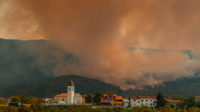If you think cities are dying—with urbanites fleeing density during the pandemic, never to return—you can think again. With the release last month of details of the 2020 U.S. census, we now know that metropolitan areas gained population in the last decade.
Still, city-bashing goes on: “Anti-urbanism is an American religion, practiced widely and frequently in ordinary times, and passionately when cities are actually in trouble,” sociologist Eric Klinenberg told The New York Times, in a recent article about pandemic predictions of urban demise. Throughout U.S. history, cities have been seen as hotbeds of crime and disease—and for being places where people of different races come together. As Andre M. Perry of the Brookings Institution has noted, “social distancing” was familiar long before Covid in urban Black communities that have been subject to segregation and racist housing policies.
But now, with 86 percent of Americans living in metro areas, comes the opportunity to address the real problems of cities. While the planned return of people to offices and schools this month has been tempered with uncertainty over coronavirus variants, the recent focus on inequities in health care, education, public space, and the environment make this a moment not to be squandered: we need to find solutions for the most urgent urban crises now.
For this issue, RECORD reached out to a number of experts in urbanism and architecture and asked how they would reimagine the city. The Harvard urban economist Edward Glaeser and health economist David Cutler discuss their new book, Survival of the City: Living and Thriving in an Age of Isolation. Their biggest concern for cities: the widening gap between the wealthy elite and young people, immigrants, and entrepreneurs who have always helped recharge the batteries of the urban engine.
Thomas Dyja agrees. In an essay for RECORD, the award-winning author of New York, New York, New York: Four Decades of Success, Excess, and Transformation, calls for “reducing the inequalities that threaten our democracy.” “These past 40 years have been built on the fantasy that ‘the market’ is the only solution,” he writes about New York. “City Hall should have a positive relationship with developers, but it shouldn’t be better than the one it has with the people of New York”.
The climate crisis is an enormous threat too, and, while critic Martin Pedersen, who lived in New Orleans for the last decade, recounts the challenges in bringing resilience to that water-bound city, architect and scholar Germane Barnes explains the need for social resilience in Miami, where rising seas and gentrification have pushed Black residents out of their inland communities, once considered far less desirable.
David Brown, the artistic director of the Chicago Architecture Biennial, opening later this month, has mapped 13,000 publicly owned vacant lots in that city—which, he notes, are often in marginalized neighborhoods. Brown believes innovative urban-design approaches can transform such properties for the surrounding communities, as will be highlighted in the Biennial, with its theme “The Available City”.
When asked what the greatest challenges are today in Los Angeles, Christopher Hawthorne, the city’s Chief Design Officer, says “housing, mobility, and equity.” Hawthorne and his colleagues have devised alternatives to the single-family houses that dominate L.A.’s sprawl, to help spark new thinking about the severe affordable-housing shortage there.
In this issue we also interview Rosanne Haggerty, a leading authority on dealing with the crisis of homelessness, whose nonprofit organization Community Solutions was awarded a staggering $100 million grant from the MacArthur Foundation to expand its work.
Also in this issue is a portfolio of innovative housing solutions—as well as an array of public-space improvements; a Continuing Education course on converting office space to apartments; and RECORD’s annual Building Type Study on multifamily housing, with superb examples of urban architecture in the U.S. and Europe.
If mankind can harness the will to successfully tackle the climate crisis—and cities are not underwater or on fire—surely humanity can transform the urban realm into fair, open, and equitable places, where everyone finally will have an opportunity to thrive.






